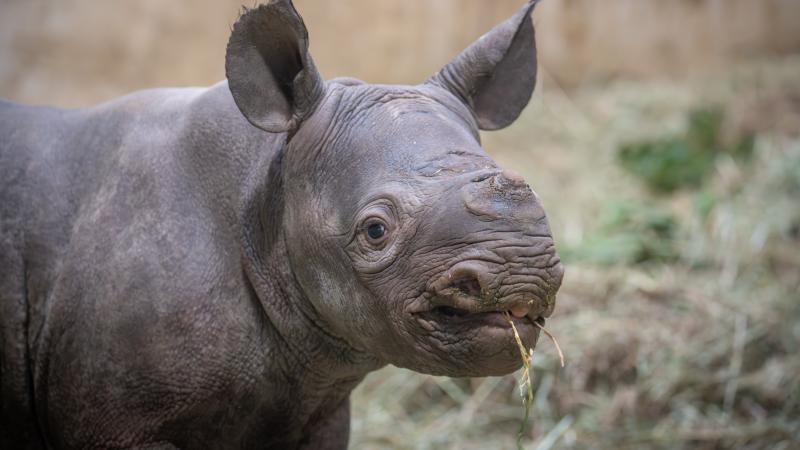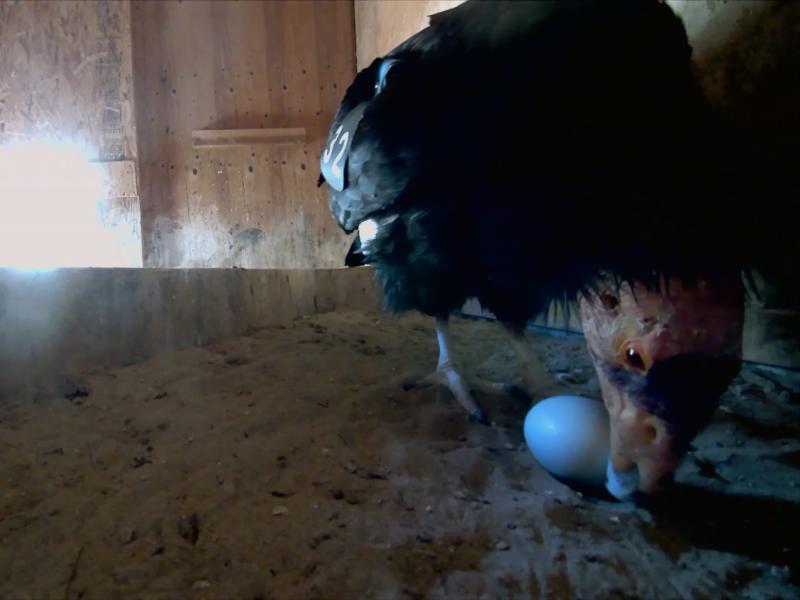Endangered rhino calf is a month old and growing fast

Eastern black rhinoceros baby is developing quickly in size and independence
The smallest member of the zoo’s rhinoceros family reached a big milestone this week: Jozi and King’s calf is one month old. Born Dec. 4 at around 100 pounds, the youngster now weighs 172 pounds and is beginning to explore the behind-the-scenes rhino maternity den.
“Both Jozi and her calf are doing great,” said Chad Harmon, who supervises the zoo’s rhino area. “Their bond is strong, and we’re seeing the calf explore the barn more and more.”
Animal-care staff continue to take a hands-off approach with the new arrival but are still closely monitoring the rhino family to make sure everything continues to go well. Veterinary staff have not yet determined the sex of the new baby.
“When the calf is ready for that first veterinary exam, we’ll find out whether it’s a boy or a girl,” Harmon said. “For now, Jozi is doing such a great job that we haven’t needed to intervene. She’s a terrific mom.”
Jozi and her baby are currently off-view to allow the new family a comfortable place to continue to bond. Guests will have to wait until the baby’s a little bigger — and until the weather’s warmer — before they begin exploring Rhino Ridge.
Harmon, a longtime rhino benefactor, is a board member of the International Rhino Keeper Association, which works to develop and share best practices for caregivers and contribute to rhino conservation.
Jozi’s baby holds much significance for the species, according to Kelly Gomez, who oversees the zoo’s Africa area. Jozi and her companion, King, belong to the eastern subspecies of black rhinoceros, which is considered critically endangered. In 2011, the western subspecies of black rhino was declared extinct.
“These rhinos represent a species that’s among the most endangered on the planet,” Gomez said. “Poaching and the illegal wildlife trade have wiped out 96% of the world’s black rhino population. In South Africa alone, we’re losing almost a rhino a day. Hopefully, their story can help inspire a new chapter in the conservation of this incredible species.”
“We’ve gone from half a million to a few thousand rhinos left in the blink of an eye,” noted U.K. naturalist Steve Backshall. “While those left in the wild are ludicrously precious, the rhinos that are in zoos (which were bred there, born there and cannot ever be released into the wild) are of disproportionate importance to their kind.”
Jozi, who weighs around 2,400 pounds, was born Sept. 8, 2012, at the Pittsburgh Zoo. Keepers named her after her parents: “Jo-” from her father, Jomo, and “-zi” from her mother, Azizi.
Jozi moved to the Oregon Zoo in 2021 from to the Milwaukee County Zoo, joining male rhino King, the baby’s father, who arrived from Chicago’s Brookfield Zoo earlier that year. The moves were based on a recommendation from the Association of Zoos and Aquariums’ Species Survival Plan for rhinos. The AZA has established Species Survival Plans for many threatened or endangered species — cooperative programs that help create genetically diverse, self-sustaining populations to guarantee the long-term future of these animals.
More News

Zoo convenes action for imperiled elephants
Sabah government representatives joined conservation NGOs, local communities, palm oil producers, and tourism operators this week in the fight to save the world’s smallest elephants from extinction.April 11, 2025

Double fluff: Zoo welcomes first condor chicks of season
The first two California condor chicks of 2025 hatched at the Oregon Zoo’s Jonsson Center for Wildlife Conservation.April 3, 2025

Thirteen eggs and counting at zoo's condor recovery center
At the Oregon Zoo’s Jonsson Center for Wildlife Conservation, endangered California condors have laid 13 eggs — with the potential for more on the way.March 11, 2025

